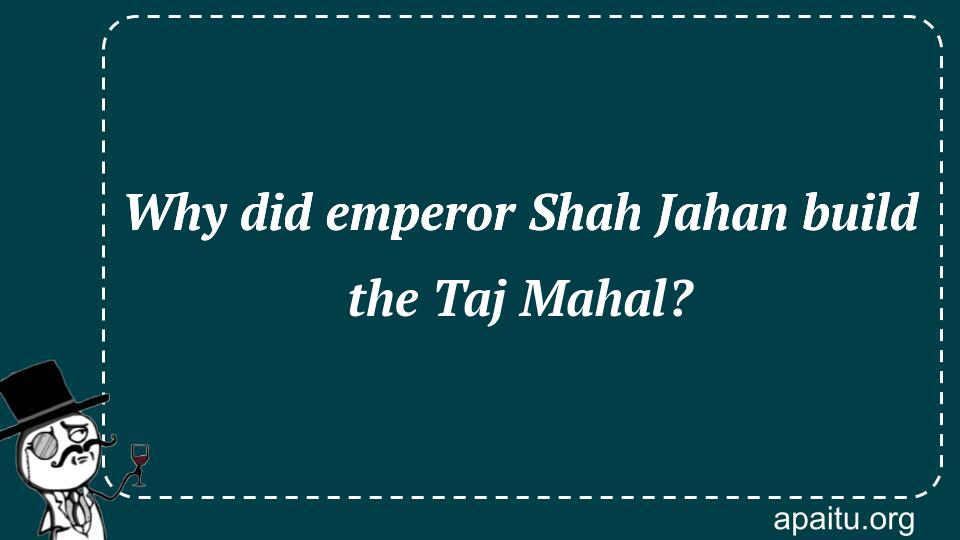Question
Here is the question : WHY DID EMPEROR SHAH JAHAN BUILD THE TAJ MAHAL?
Option
Here is the option for the question :
- In memory of his wife
- As a temple
- As a palace
- In honor of his ancestors
The Answer:
And, the answer for the the question is :
Explanation:
The Taj Mahal was erected in 1631 in the Indian city of Agra by Mughal Emperor Shah Jahan as a spectacular show of eternal love to his third wife, Mumtaz Mahal, who died that year in childbirth. The couple’s last resting place is the symmetrical white marbled masterpiece – Mahal was buried there after her death, and Jahan was placed next to her when he died in 1666.

IN MEMORY OF HIS WIFE: The Eternal Love Behind the Taj Mahal
The Taj Mahal, one of the most magnificent architectural wonders in the world, stands as a testament to love and devotion. Built by Emperor Shah Jahan, the Taj Mahal is a mausoleum located in Agra, India, and its creation is intrinsically tied to a heart-wrenching love story. Shah Jahan commissioned the construction of this awe-inspiring monument in memory of his beloved wife, Mumtaz Mahal, as a symbol of their eternal love and as a tribute to her enduring legacy.
Mumtaz Mahal was Shah Jahan’s favorite wife and his true soulmate. They shared an extraordinary bond, and Mumtaz Mahal was not only his wife but also his trusted confidante and advisor. Tragically, she passed away during the birth of their 14th child in 1631. Devastated by her untimely death, Shah Jahan was determined to honor her memory in a manner befitting her status and their profound love.
The construction of the Taj Mahal began in 1632 and took approximately 22 years to complete. Shah Jahan spared no expense in creating a masterpiece that would stand as a symbol of his undying love for Mumtaz Mahal. The Taj Mahal’s design incorporates elements of Persian, Islamic, and Indian architectural styles, resulting in a harmonious fusion of beauty and grandeur.
The white marble mausoleum, adorned with intricate carvings and inlaid gemstones, stands on a raised platform and is flanked by four minarets. The central dome, reaching a height of 240 feet (73 meters), is a marvel of engineering and craftsmanship. Reflecting pools and lush gardens surround the Taj Mahal, adding to its ethereal ambiance and creating a serene and picturesque setting.
The Taj Mahal’s beauty lies not only in its architectural brilliance but also in the deep symbolism it represents. It is a testament to the eternal love between Shah Jahan and Mumtaz Mahal, an eternal love that transcends time and death. The Taj Mahal captures the essence of their relationship, serving as a physical embodiment of their profound connection.
Beyond being a personal tribute, the Taj Mahal also serves as a symbol of the Mughal Empire’s grandeur and cultural heritage. It stands as a testament to the opulence and artistic excellence that characterized the Mughal era. The monument’s significance extends beyond its romantic origins, becoming a global icon that attracts millions of visitors each year, marveling at its beauty and appreciating its historical and cultural importance.
The Taj Mahal has been recognized as a UNESCO World Heritage Site and is considered one of the Seven Wonders of the World. Its architectural splendor, combined with the love story behind its creation, has cemented its place as a global treasure, captivating people from all walks of life.
the Taj Mahal stands as an enduring symbol of love and devotion. Emperor Shah Jahan built this remarkable monument in memory of his beloved wife, Mumtaz Mahal, to immortalize their eternal bond. The Taj Mahal’s architectural brilliance and exquisite beauty continue to inspire awe and admiration centuries later. It is a testament to the power of love and the profound impact it can have on shaping the world around us. The Taj Mahal is not just a physical structure; it is a living testament to the enduring power of love and the timeless beauty of human expression.